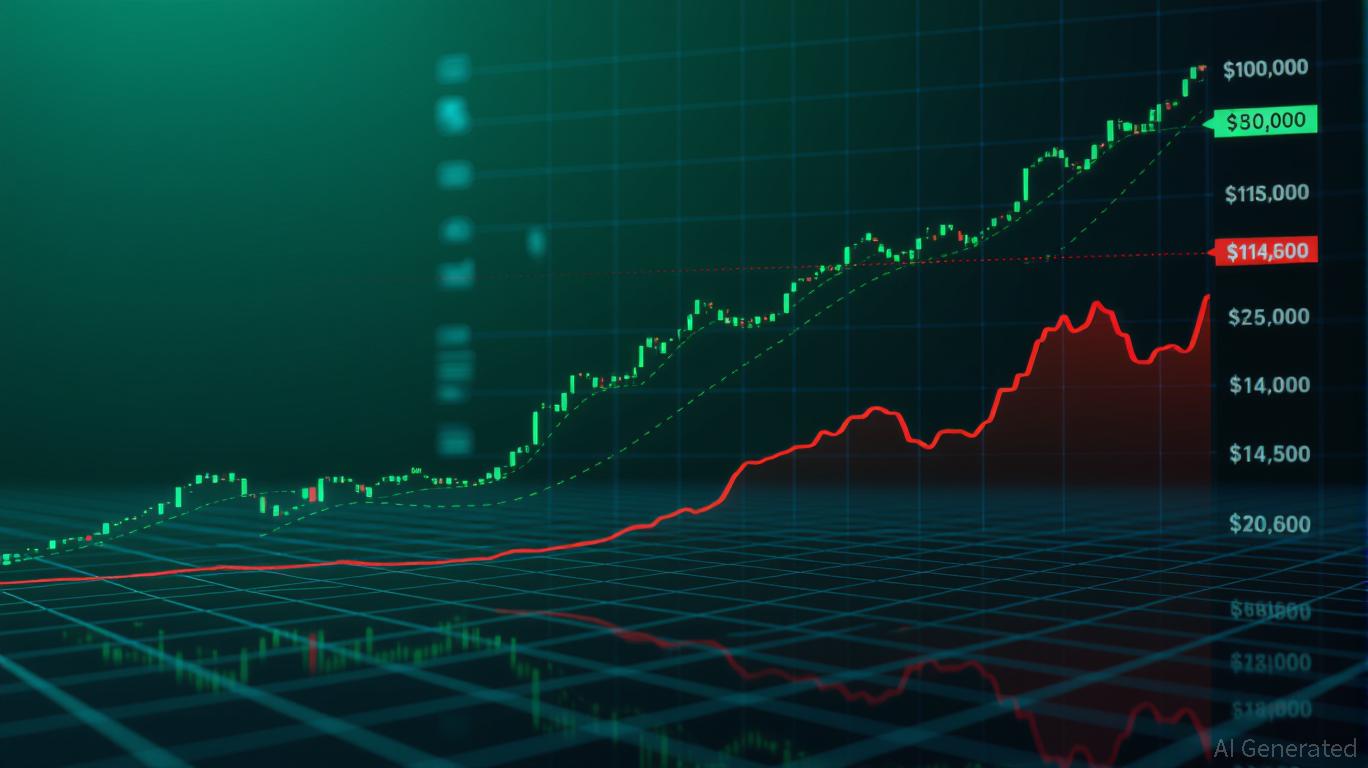Bitcoin’s Price Rally in November 2025: The Intersection of Institutional Investment and Global Economic Changes
- Bitcoin surged to $114,600 in November 2025 amid Fed rate cuts, geopolitical tensions, and whale accumulation despite ETF outflows. - Institutional adoption shifted toward privacy tokens like Zcash for compliance, yet 140+ firms hold $137B in crypto including Bitcoin. - Whale buying (36,000 BTC added) countered short-term redemptions, while JPMorgan and MicroStrategy expanded Bitcoin holdings. - Geopolitical risks and fiat devaluation concerns boosted Bitcoin's appeal as a decentralized hedge over tradit
Institutional Adoption: Privacy Tokens and Bitcoin
Interest from large institutions in
Nevertheless, Bitcoin continues to play a vital role in institutional investment strategies. Even though spot and
Galaxy Digital's updated 2025 projection of $120,000 reflects worries about institutional capacity and forced liquidations, but the increased Bitcoin reserves at JPMorgan and MicroStrategy's all-time high holdings point to a wider institutional commitment, according to a

Macroeconomic Catalysts: Fed Policy, Inflation, and Geopolitical Tensions
Bitcoin's rally in November aligned with a significant change in U.S. monetary policy. The Federal Reserve's decision to lower rates in September 2025, responding to a softening job market and slower economic growth, provided a boost for assets like Bitcoin that do not yield interest, according to the Bitget report. Lower inflation numbers, including a 0.3% rise in the September CPI, further encouraged risk-taking among investors, who increasingly favored growth assets, as highlighted by the Coinotag analysis.
Global political unrest also contributed. Rising conflicts in the Middle East and ongoing U.S.-China trade tensions prompted investors to seek out safe-haven assets. Bitcoin outshone traditional refuges such as gold, reaching $114,600 in the third quarter of 2025 as institutional demand for hedging instruments grew, according to the Bitget report. Analysts emphasize that Bitcoin's decentralized structure and capped supply make it a compelling option for protecting against currency devaluation during periods of geopolitical uncertainty.
The Interplay of Institutional and Macroeconomic Forces
The intersection of these influences has produced a distinctive market setting. Although ETF redemptions and Galaxy Digital's cautious stance suggest prudence, macroeconomic support and continued whale buying point to a fundamentally optimistic outlook. Institutional engagement is evolving: privacy tokens are helping meet compliance demands, but Bitcoin's status as a value store remains unshaken.
Michael Saylor's forecast of $150,000 for late 2025 is based on the ongoing development of Bitcoin's institutional framework, including derivatives and risk management solutions, as noted in the Coinotag analysis. Should global tensions persist and inflation stay low, Bitcoin may attract renewed interest from both corporate treasuries and large-scale hedge funds.
Conclusion
Bitcoin's price jump in November 2025 highlights the increasing intricacy of its market landscape. Institutional participation is diversifying, with privacy coins gaining momentum, yet Bitcoin's fundamental appeal as a safeguard against economic uncertainty remains robust. As the Federal Reserve steers through a delicate economy and geopolitical risks continue, investors must weigh short-term fluctuations against enduring trends. For those with a long-term perspective, the combination of institutional innovation and macroeconomic drivers in Bitcoin offers both risks and rewards.
Disclaimer: The content of this article solely reflects the author's opinion and does not represent the platform in any capacity. This article is not intended to serve as a reference for making investment decisions.
You may also like
Ethereum News Update: Is Ethereum Really Headed for $60k? Kiyosaki's Confident Prediction or Just a Mistake?
- Robert Kiyosaki predicts Bitcoin could hit $250,000 and Ethereum $60,000 by 2026, challenging traditional finance norms. - His strategy emphasizes Bitcoin/gold as inflation hedges, citing Gresham's Law and Metcalfe's Law to justify decentralized asset accumulation. - Market reactions are mixed: critics dismiss his long-term crash warnings, while on-chain data and Arthur Hayes support potential rebounds. - Kiyosaki's bullish stance highlights growing crypto legitimacy as value stores, despite regulatory r

Bitcoin Updates: SoFi Integrates Banking with Cryptocurrency, Providing Safe Trading via an FDIC-Insured Application
- SoFi becomes first FDIC-insured U.S. bank to launch consumer crypto trading via its app, integrating banking and digital assets under regulatory oversight. - The service enables users to trade Bitcoin , Ethereum , and Solana directly from FDIC-protected accounts, emphasizing "bank-grade" security and eliminating external fund transfers. - A 60% user preference for bank-based crypto trading and 2025 regulatory clarity from OCC support the move, aligning with doubled U.S. crypto ownership and industry tren

SEC's Token Classification Ignites Regulatory Dispute With CFTC Over Cryptocurrency Oversight
- SEC proposes token taxonomy framework to classify crypto assets, excluding decentralized tokens and utilities from securities under the 1946 Howey Test. - Bipartisan bills aim to shift crypto commodity oversight to CFTC, raising concerns over agency capacity amid staffing shortages and pending leadership confirmations. - Regulatory overlap between SEC and CFTC intensifies as Congress seeks cohesive frameworks, balancing innovation incentives with investor protections in evolving crypto markets.

IPO Genie's Airdrop Connects Individual Investors with Elite Private Market Opportunities
- IPO Genie's $50,000 airdrop drives 320% sign-up surge, rewarding 40 participants with $IPO tokens for private-market access. - AI-powered blockchain platform offers utility-focused tokens with staking/governance rights, raising $12.5M from 40+ countries. - Merkle tree verification and linear vesting enhance credibility, though phishing risks and liquidity volatility remain concerns. - Phase 5 at 95% capacity creates urgency as stricter eligibility and higher prices loom in Phase 6, per Blockchain Reporte
